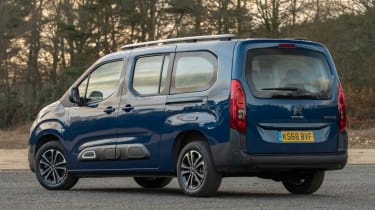Used Citroen Berlingo (Mk3, 2018-date) review
A full used buyer’s guide on the Citroen Berlingo covering the Berlingo Mk3 that has been on sale since 2018
Verdict
The third-generation Berlingo is genuinely plush if you buy towards the top of the range. It’s better to drive and built to a higher standard than ever, and with only electric powertrains available from 2022, the earlier petrol and diesel models could be a good investment for the next few years.
When it comes to thinking outside the box, Citroen has a long and rich history of doing things differently. So when it thought up the van-derived people-carrier that was the original Berlingo in 1996, we shouldn’t have been surprised.
Within a year, Renault had retaliated with the Kangoo, and the van-based MPV soon took off – more so in Europe than in the UK, though, because we’re less keen on utilitarian transport. But for those who wanted something cheap, comfy and practical, there was little that could touch the Berlingo. A second generation arrived in 2008, with an all-new model appearing a decade later.
History
The third-generation Citroen Berlingo went on sale in July 2018 in Feel and Flair trims and five-seat M and seven-seat XL editions, with the latter being 35cm longer.
There was one 1.2-litre PureTech three-cylinder petrol engine with 109bhp or 128bhp, with six-speed manual and eight-speed automatic transmissions respectively. Diesel fans could buy a 1.5-litre BlueHDi with 74bhp, 99bhp or 128bhp. The first two were available only with a manual gearbox, but the BlueHDi 130 could be bought with a six-speed manual or eight-speed automatic. All engines were offered with the Berlingo M, but the BlueHDi 75 wasn’t available in XL form.
Used - available now

2020 Citroen
Berlingo
20,577 milesAutomaticDiesel1.5L
Cash £16,516
2024 Citroen
Berlingo
35,420 milesAutomaticDiesel1.5L
Cash £14,822
2020 Citroen
Berlingo
64,848 milesManualDiesel1.5L
Cash £13,300
2021 Citroen
Berlingo
39,012 milesManualDiesel1.5L
Cash £16,750In June 2019 Citroen added Flair XTR trim, but only with the BlueHDi 100 and 130 engines. The Rip Curl special edition of December 2020 came with BlueHDi 100 or PureTech 130 powerplants. It didn’t feature any extra standard equipment and was available only with white paint (grey or black were extra-cost options) along with unique decals and interior details. From October 2021 Rip Curl replaced Flair trim.
In January 2022, all petrol and diesel Berlingos went off sale, with only a fully electric version available. The e-Berlingo has a 134bhp electric motor and is fitted with a 50kWh battery for a claimed range of up to 177 miles. There were still M and XL editions, both available in Feel and Flair XTR trims.
Which one should I buy?
The BlueHDi makes the most sense. It’s the most readily available, the most frugal, the cheapest to buy and also has the longest range. It also has plenty of torque, so whether you’re loaded up or towing, it makes the lightest work of long-distance journeys.
The PureTech editions are good to drive and reasonably cost-effective to buy, but you’ll pay more to run one, thanks to reduced fuel economy. The e-Berlingo is much more expensive, but running costs will be lower, although a real-world range of 140-150 miles might be a problem for some.
Even the entry-level Berlingo Feel is pretty well equipped. As standard, Citroen fitted an eight-inch touchscreen, DAB radio, Android Auto and Apple CarPlay, air-con, cruise control, electric front windows, rear parking sensors and auto emergency braking. The Feel also came with 16-inch steel wheels and pop-out rear side windows.
Flair added electric windows and privacy glass, power-folding door mirrors, an auto-dimming rear-view mirror and 16-inch alloys. The Flair XTR featured a head-up display, a rear camera and 17-inch wheels.
Alternatives to the Citroen Berlingo Mk3
The Peugeot Rifter and Vauxhall Combo Life are effectively the Berlingo rebadged, with similar engines, specs and prices. Launched in 2014, the Ford Tourneo Connect is good to drive, roomy, well made and versatile, with a choice of efficient petrol or diesel engines.
Also take a look at the Volkswagen Caddy Life, the latest version of which was launched in 2021. Based on the same platform as the Golf, it’s dynamically very capable, well made, looks smart and has plenty of versatile space.
What to look for
AdBlue
Citroen says the diesel Berlingo’s AdBlue tank needs filling every 14,000 miles, but 8,000-10,000 miles is more typical.
Tyres
Which treads you fit and what pressure they’re kept at have a big effect on the way the Berlingo drives. Owners rate Michelin Cross Climates.
Spare wheel
Some Berlingos were supplied with a tyre mobility kit rather than a spare wheel, but full-size spares are available from Citroen dealers.
Storage
The Flair XTR gets a panoramic glass roof and Modutop. The latter is an internal roof storage system, but XL editions didn’t get it, only the M.
Common faults
Citroen achieved a disappointing 28th in the 2021 Driver Power brands survey, with 23 per cent of owners experiencing a fault of some description. Check the service and MoT history of any Berlingo you look at.
Interior
This is one of the Berlingo’s highlights. Whether you buy a five or seven-seat version, you’ll have masses of carrying capacity: 775 or 1,050 litres respectively with the back seats in place, and 3,500 or 4,000 litres with them folded.
Versatility is superb, with the XL capable of swallowing loads up to three metres long thanks to a folding front seat. There’s lots of head and legroom for five occupants, too, although the seven-seater is a bit tighter in the rearmost row.
The eight-inch touchscreen infotainment system that came standard with the Berlingo looks smart enough, but the controls are a bit fiddly.
Running costs
BlueHDis and e-Berlingos need servicing every two years/ 25k miles, although the latter should have an inspection every 12 months or 12,500 miles. The intervals for PureTech models built up to Nov 2019 are every year or 16k miles; after that the limit was reduced to 12,500 miles.
The schedule runs interim/main/interim/major for PureTech and BlueHDi cars. The interim is an inspection and fluid top-up. You can choose between pattern parts (£189) and genuine parts (£199). The main service is priced at £219 or £249; a new pollen filter is included.
The major service includes a new air filter and a fuel filter (diesel) or spark plugs (petrol). Dealers charge £309 or £369 for a major BlueHDi service, but PureTech models are priced at £339 or £399. The e-Berlingo alternates between interim and main services, at £70 and £229.
Fresh brake fluid is required every two years (£65). Every six years or 62,500 miles, the petrol unit has a cambelt change, which costs £569, or £449 with pattern parts.
Recalls
Citroen has recalled the third-generation Berlingo seven times. The first two campaigns were in April 2019, one for a faulty part in the handbrake mechanism, the other for a plastic component within the exhaust which could damage the diesel particulate filter.
Two more recalls came in November and December 2019, the first because of faulty seatbelts and the second because of faulty steering columns. A recall was issued in February 2020 because the urea injector for the AdBlue system could become blocked.
Sub-standard tie rods in the front suspension were the reason behind recall number six in July 2020, then in January 2021 came the most recent campaign, because the timing belt could break up, leading to the brake servo being damaged.
Driver Power owner satisfaction
No Citroens appeared in the 2021 Driver Power new-car survey, but the previous year saw four in the top 75: Grand C4 SpaceTourer (28th), C3 Aircross (66th), C1 (72nd) and C4 Cactus (73rd). The Berlingo sells in too low volumes to appear, but Citroens in general sit in the lower half of the rankings.
In our brands survey, Citroen finished in 18th place out of 33 companies represented, putting it above premium firms such as MINI, Mercedes, BMW and (just) Volkswagen.
Looking to sell your current car quickly and for a good price? Try our Free Car Valuation tool today!










